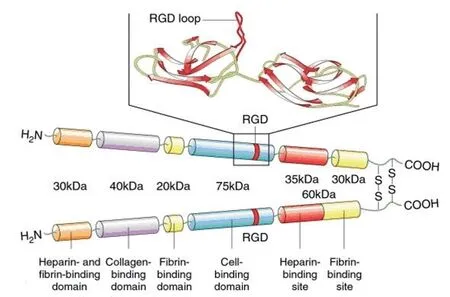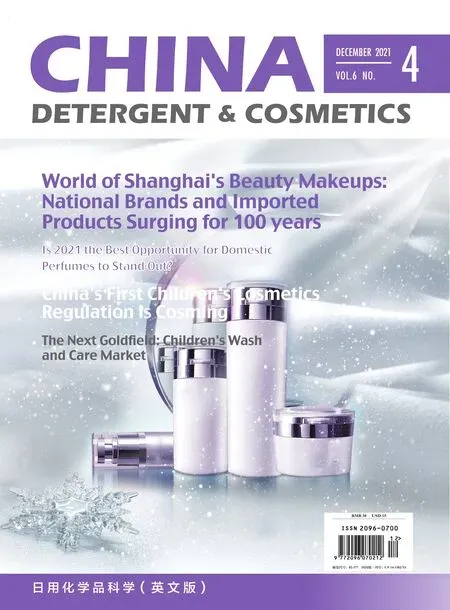Research Progress and Cosmetic Application of Fibronectin
Zou Jie,CHEN Laicheng
Guangzhou Zoom-i Cosmetic Co.,Ltd.,China;
Wu Yaqin
Guangzhou Hengya Biochemical Co.,Ltd.,China;
Ye Zhuhong
Suzhou shipu test technology Co.,Ltd.,China
Abstract Fibronectin (FN) is a widely existed glycoprotein in human body fluid and plays an important role in the process of wound repair in human tissue.With the in-depth study on the molecular mechanism of fibronectin for wound repair,its applications in emerging biomedical fields are becoming more extensive,such as the field of skin wound repair and the field of tissue engineering materials,which are gradually extended to the field of beauty and skin care.In this paper,the domestic and foreign academic research and application of fibronectin were briefly reviewed.
Key words Fibronectin;wound repair;biological tissue material;cosmetics
1 Research history of fibronectin (FN)
Fibronectin (FN) was first discovered by Morrison in 1948 and identified as a contaminant of fibrinogen prepared by the Cohn cold ethanolfractionation process[1].In a subsequent study by Mosesson et al.,in 1970,the contaminant was clearly identified as a distinct plasma protein (i.e.,coldinsoluble globulin)[2].Between 1973 and 1978 multiple groups of research reports on the identification of large cell surface glycoproteins emerged[3–7].Considering that there is considerable similarity between the structures of plasma cold-insoluble globulin and those of phospholipid proteins on the cell surface[8],and fibronectin exists in soluble form in blood and in insoluble form on the cell surface and extracellular matrix.The special term Fibronectin was created to name fibronectin,which describes the fiber properties and gel-like properties of protein[9].
Due to its precipitate property when exposed to cold,Fibronectin was originally called Cold insoluble globulin,and now it is generally called fibronectin(abbreviated as FN).There are more than 20 species in the human body,which are widely distributed in blood,body fluid and various tissues.Fibronectin(FN) is an important component commonly found in the extracellular matrix (ECM).The research on fibronectin (FN) in China started from 1980s to 1990s and is still at a primary level.At the beginning of the study,it was mainly focused on the exploration of the clinical application of fibronectin (FN),and there were few studies at the molecular mechanism level.
In recent years,with the development of functional skin care products,during the discussion on the medical application of fibronectin (FN) in China,it was found that fibronectin (FN) had a unique effect in medical beauty,and dermatologists have successively studied the application of fibronectin in functional skin care.At the same time,biochemical synthesis methods were successively studied to obtain fibronectin,so as to find a breakthrough for the large-scale and cheap application of fibronectin in cosmetics.
2 Classification of fibronectin (FN)
At present,three subtypes of fibronectin have been found.It is produced by liver and vascular endothelial cells and exists in plasma and body fluid in a soluble state,commonly known as Plasma fibronectin (pFN);Those synthesized by different types of cells,such as fibroblasts,astrocytes,earlystage mesenchyme,deposit in different forms on the cell surface,extracellular matrix,intercellular space,basement membrane and connective tissue species,commonly known as Cellular Fibronectin (cFN);It is synthesized by embryonic tissue,malignant tumor and placental tissue,commonly known as Fetal Fibronectin(fFN),mainly due to FN[10]generated by overexpression of gene sequences EIIIA and EIIIB.
3 Structure and function of fibronectin (FN)
Fibronectin (FN) is a large glycoprotein with molecular weight of about 440,000 Daltons,which is a dimer formed by connecting two subunits with molecular weight of 220,000 Daltons through disulfide bonds.The whole molecular shape is composed of two similar A-chains and B-chains,showing a V-shape.Analysis of amino acid,gene,and genomic DNA sequences revealed that fibronectin (FN) was a multidomain glycoprotein consisting of a series of multiple repeating module structures,12 FN I-type repeats (FNI),two FN II-type repeats (FN II),15 constitutive expressions,and two alternatively spliced(referred to as EIIIA and IIIb herein) FN III-type repeats,as well as a region of a non-homologous variable (V) or III-type connecting fragment (IIICS).The multi-module structure and the inter-module region provide flexibility for fibronectin (FN) molecules to participate in the regulation of their functions[11–16].

Figure 1.Fibronectin structure diagram
These modules are organized into energy domains,and specific domains can interact with a variety of binding partners,including other ECM components and cell surface receptors[17].The binding domains of multiple substances on each FN subunit were closely related to their functions:Two heparin-binding domains;Three fibrin binding domains;A collagen binding domain,where the collagen binding domain on FN binds to collagen in the cell matrix,thus adsorbing the cells on the extracellular matrix;One to two eukaryotic cell binding domains were located in 10Fn III,while the second domain was located in 9Fn III.The fibronectin recognized and bound to the integrin heterodimer through the arginine–glycine–aspartic acid sequence(Arg-Gly-Asp,RGD) on fibronectin 10Fn III and 9Fn III,thereby affecting cell adhesion and migration.A prokaryotic cell binding domain,located at the amino end,capable of binding to Staphylococcus aureus;DNA binding domain,which is close to the carboxyl end of collagen binding domain[10].
4 Research progress of fibronectin mechanism
Fibronectin (FN),as an essential high-molecular glycoprotein in human body,is widely present in tissues and tissue fluid.In the vital activities of the body,FN is involved in cell migration,adhesion,proliferation,hemostasis,tissue repair adhesion,and embryo development.It has the effect of growth factors,which can promote cell proliferation,induce epidermal cells to pass through granulation tissue,and promote the reconstruction of the basement membrane under the epidermis and the normal keratosis.FN is also involved in many pathological processes of the body.
Fibronectin has various adhesion functions,such as intercellular adhesion,cell adhesion to plastic or basement membrane,and clot stabilization.Fibronectin is also important in wound healing.Soluble fibronectin deposited on damaged collagen and fibrin enhances platelet adhesion,phagocytic and fibroblast migration,and cell proliferation.
When studying the role of FN in wound repair,we found that in the coagulation stage at the early stage of trauma,FN was released from platelets and deposited on damaged collagen and fibrin,which would enhance platelet adhesion,migration of phagocytes and fibroblasts,and cell proliferation.FN activated neutrophils,enhanced their adhesion,and accelerated their aggregation to the wound area.In the middle stage of wound repair,FN is an important chemokine of fibroblasts that enhances cell adhesion and chemotaxis by helping to maintain cytoskeletal structure.When FN is cross-linked with fibrin,it attaches to the blood clot,which helps the fibroblasts move thereon and quickly enter the wound area.Fibroblasts entering the trauma area can secrete large amounts of FN,which is co-deposited with type III collagen in the intercellular substance.When the fibroblasts spin out a fibrinogen web,the actual healing process begins.The web acts as a scaffold on which collagen,heparan sulfate,proteoglycans,chondroitin sulfate,and other extracellular matrix components are deposited.Fibronectin also enhances neovascularization by stimulating endothelial cell migration.Finally,fibronectin,as a guide for the movement of epidermal cells through granulation tissue,contributes to the reorganization of the subepithelial basement membrane,where normal keratinization can occur[18].
In 2017,Maxwell B.Johnson et al.demonstrated that fibronectin could reduce the response to radiation in the skin of mice through mouse wound model experiments in their paperTopical Fibronectin Improvements Women’s Hospital of Irradiated Skin.In addition,topical fibronectin gel can significantly promote healing of irradiated skin wounds.This is mainly because fibronectin can significantly reduce acute inflammation and promote angiogenesis.These findings prove that fibronectin may be involved in the pathogenesis of poor wound healing after radiationinduced skin injury,and exogenous supplement of fibronectin contributes to the repair of radiationinduced damaged tissues[19].
In their research to observe the effect of fibronectin (FN) in the treatment of oral ulcer,Wang Bin et al.found that the therapeutic spray containing fibronectin had a significant effect on oral ulcer,rapidly reducing the area of oral ulcer and promoting the healing of ulcer surface,and relieving various pains caused by oral ulcer.The spray was very safe and had no side effects[20].
The artificial dermis Dermagraft[21]produced by Advanced Tissue Sciences Co.,Ltd.inoculated fibroblasts obtained from neonatal foreskin on a bioabsorbable polylactic acid grid,and the fibroblasts proliferated in large amounts and secreted collagen,fibronectin (FN),proteoglycan,growth factors,and others 14~17 days later,to form the artificial dermis composed of fibroblasts,extracellular matrix,and degradable biomaterials.Dermagraft can be used for burn wounds and chronic skin ulcer wounds.Studies have shown that Dermagraft can effectively reduce wound contraction and promote the adhesion and growth of the epidermal cell membrane inoculated thereon.

In 2021,Shan Yufei et al.proposed a method for efficiently and inexpensively obtaining recombinant fibronectin FN by biological fermentation[22]and obtained the invention patent (PatentNo.CN202010438531.4).The method provides a fibronectin FN biological fermentation synthesis path for skin cosmetology,adopts biotechnology to carry out combined expression of conus peptide functional domain and fibronectin,and adopts a high-density fermentation process,a super-tolerant metal affinity chromatography purification process,a specific protease excision label and an ion column refining purification process to carry out scale production of recombinant fibronectin and obtain micromolecularity human-like fibronectin.
5 Application of fibronectin (FN)
After entering the 21st century,molecular biology has entered the era of rapid development,which also led to the rise of human tissue engineering,promoted the breakthrough of fibronectin (FN) in the micro field,and the research in emerging fields such as cancer and biological materials have mushroomed.In recent years,there have been more and more studies on the clinical application value and fields of fibronectin(FN).Through the efforts of many scientific research workers,doctors and scholars engaged in translational medicine research and clinical application research,there have been breakthrough advances in research on tumors[23,24],anti-infection[25],research and application in biological materials,etc.
In the repair and healing of skin wounds,fibronectin can shorten the wound healing time and reduce wound scars,which is widely used in regenerative medicine.In the aspect of skin care,fibronectin (FN) has multiple uses,which are specifically shown as follows:
Wrinkle-removing effect:The formation of wrinkles is mainly caused by the loss of collagen,elastin and reticular fibers that support the skin.Collagen is the most important extracellular matrix component,which together with other extracellular matrix components maintains the elasticity,toughness and luster of the skin.Fibronectin (FN),as an important signaling molecule,induces the expression and secretion of collagen in the extracellular matrix,promotes the secretion of hyaluronic acid and other glycoprotein molecules,and affects the directional arrangement of ECM.Therefore,fibronectin (FN)plays a good role in smoothing wrinkles.
Spot fading and Whitening effect:The skin needs to maintain normal physiological metabolism,including:keratinocyte shedding and regeneration,regulation of melanin cell contents,etc.It has been found that abnormal normal physiological metabolism not only leads to scars,but also leads to disordered regulation of melanin cells and color spots.Pigmentation refers to the proportion of skin constituent cells as well as structural and functional abnormalities.FN promotes normal physiological metabolism of skin and also has the ability to prevent abnormal secretion of melanin cells.
6 Application prospect of fibronectin(FN) cosmetics
Due to its unique medical and pharmaceutical value,some domestic biotechnology companies have also launched some beauty products containing fibronectin (FN).And the gradual industrialization and market promotion have revealed that the research,development and application of fibronectin (FN) have a broad development prospect in China.


 China Detergent & Cosmetics2021年4期
China Detergent & Cosmetics2021年4期
- China Detergent & Cosmetics的其它文章
- Progress of Study on Cistanche Application in Cosmetics
- Experimental Method Of Cosmetics Human Efficacy Evaluation—Delaying Skin Aging Efficacy
- Mechanism of Novel Natural Products Maintaining Skin
- Discussion on the Efficacy Evaluation Method of Skin Repair Cosmetics
- Study on Synergistic Effect and Mechanism of Sunscreen Bemt and Mbbt
- Interpretation of China’s Cross-border E-commerce Regulation
